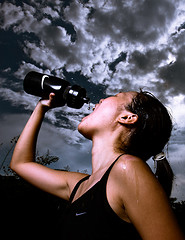Staying hydrated may be one of the most important aspects to your health and your performance while running. The human body is made up of about 66 percent water (about two-thirds of your body mass). Once the body starts to become dehydrated, it can’t function at its full capacity and your health and performance will be at risk. Being dehydrated can affect the body in many ways, especially during exercise.
Signs of being dehydrated include:
- Muscle cramping
- Headaches
- Dry mouth
- Weakness
- Unclear thinking
- Fatigue
- Bloating
- Dark yellow urine
- Significant weight loss during exercise
- Decrease of sweat during exercise

*Thirst is generally not a good indicator to determine dehydration. If you’re feeling thirsty, then you’re already dehydrated.
Sweat is one of the major components that helps regulate body temperature. If the body can’t sweat due to being dehydrated, then the body temperature can rise and you can find yourself at risk for heat-related injuries such as heat cramps, heat stroke and heat exhaustion. Heat stroke can be deadly, so hydration should be taken seriously.
A common question among runners is “how much water should I be drinking?”
This is really a two-part question. A runner most likely intends to ask about how much water should be consumed during exercise. But if enough water is not consumed throughout the day, then it won’t really matter how much water is consumed during a run. Dehydration has set in before the run has even started.
So, runners should not only be concerned about how much water they consume while exercising, but also how much water they drink during the day.
Determining the amount of water to drink
The average person should be consuming around eight to 10 servings of water a day, with each serving around eight ounces. That is around 64 to 80 ounces of water. If you want to know a more accurate number, then divide your bodyweight in half and drink that in ounces. This is how much water the body can use on a day-to-day basis without exercise.
If you’re running on a regular basis, the amount will go up to around 12-16 glasses a day (includes water consumed during exercise.) That’s 96 to 128 ounces of water a day! Basically, you will need about 16-24 ounces of water for every hour that you exercise.
Summary of water need
• To determine how much water you should be consuming on a daily basis, divide your body weight by half. That is amount of water in ounces you should be consuming daily without exercise.
Here’s an example: If you weigh 180 pounds, then you should consume 90 ounces of water a day.
• Add another eight to 16-24 ounces for every 60 minutes of exercise you do. The amount consumed during exercise varies from person to person. If you sweat lightly, then you will be closer to 12 ounces of water for every 60 minutes. If you sweat heavily (such as having a lot of salt caked on your body after a run) then you would drink closer to 30 ounces of water every 60 minutes.
• Another way to tell how much water you may need on a run is to weigh yourself before you run, then weigh yourself when you get back. For every pound of sweat lost, you will need 16 ounces of water to replenish it. It’s common to lose three to five pounds of sweat during a run on a hot day.
• Temperature can also affect how much water your body needs. In really hot conditions, the body will need more water so it can maintain sweat rates, to help cool the body.
Adapt the body to increased intake
This may seem like a lot of water to drink, especially during a run, but you’ll perform much better and more consistently if you hydrate yourself properly.
Practice makes perfect.
You may not be able to consume the proper amount during your runs at first, but you can build it up over time. Starting out on the low-end of the water consumption can help your body adapt to drinking while running. Over time, as you increase the water intake, your body will get used to it.
*During exercise, water may be replaced with a sports drink or a gel/water combination, especially if your run will be longer than one hour. Sports drinks and gels include carbohydrates and electrolytes that help you stay hydrated, keep your energy level up, and help avoid Hyponatremia (Hyponatremia is an abnormally low concentration of sodium in your blood.) Replacing your electrolytes can also help prevent muscle cramps.
Hydrating yourself is easy; the hard part is actually doing it.
